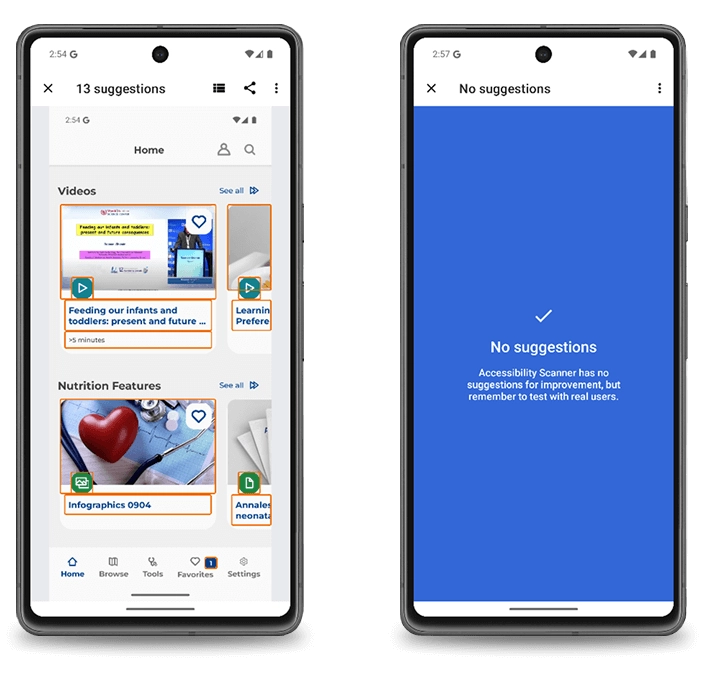A leading FMCG brand partnered with Attico to incorporate accessibility into its web ecosystem of 90 regional websites.

INDUSTRY
FMCG
CUSTOMER
A Fortune 500 multinational food and beverage corporation
SERVICES
Development
Consultation
Accessibility
Attico performed an accessibility audit and implemented accessibility improvements to the customer’s websites, enabling the company to achieve WCAG 2.0 AA compliance and adhere to in-house guidelines for accessibility.
More brands are recognizing the growing importance of accessibility in today’s digital landscape. One such case is Attico’s long-term client, an enterprise brand ranking among the top FMCG companies globally, which approached our team to help them enhance accessibility across its digital ecosystem.
In line with strict internal corporate standards and the European Accessibility Act 2025, the brand aimed to achieve WCAG 2.1 AA-level compliance for all 90 of its B2B and B2C websites. The websites belong to two large sub-brands related to child nutrition: one is a medical platform used by healthcare professionals, and the other is a consumer platform used by parents to learn more about feeding their children. Together, they form a Drupal multisite platform with a single codebase for easier management.
The client’s initial UI/UX design lacked accessibility because there were no such demands when the websites were initially designed.
As an international organization operating in Europe and other regions, the client needed to comply with international regulations like the European Accessibility Act (EAA) that came into force in June 2025. The client also needed to support regional accessibility requirements, such as those related to Israel, thus adding to the complexity.
They did so to prevent the consequences of non-compliance, including legal liability, damage to reputation, a limited user base, and individuals with disabilities being excluded from digital content and services.
The client reached out to Attico in autumn 2024, giving us about 10 months to make their digital ecosystem fully accessible.
In addition to adhering to international laws, the client needed to comply with stringent internal accessibility standards that required all digital solutions to be accessible and in line with the firm’s broader commitment to equity, usability, and universal access. In support of this initiative, the leadership of the FMCG firm formally adopted an accessibility statement, solidifying digital inclusion as a core corporate value.
For ongoing monitoring, the firm also launched periodic audits to assess its sites against applicable accessibility standards and integrate feedback from users into ongoing improvements.
One of the most significant challenges was integrating accessibility into live development workflows. While our team worked to retrofit and enhance existing digital assets to become compliant, we were also releasing corresponding new features and updates simultaneously. Ensuring consistent accessibility in the midst of a fast-paced, dynamic development environment required intense synchronization, incremental testing, and continuous adherence to accessibility best practices.
The accessibility implementation followed a structured, multi-stage approach.
The first step was a thorough accessibility audit of the client’s existing digital ecosystem, including both automated and manual checks. Axe DevTools was leveraged for automated testing to detect common accessibility issues across the websites quickly.
Attico’s accessibility experts also performed manual reviews of all sites using screen readers and keyboard navigation to identify complex issues that automation often misses, such as semantic structure, focus management, and content clarity.
We generated accessibility reports that served as a foundation for fully updating the company’s master site to align with the AA standard. The accessibility report and subsequent work were divided into three categories:

After the audit, our team mapped out the most critical user journeys and functional flows to pass WCAG Level A and AA thresholds. Prioritization was based on considerations such as user impact, legal risk, and business criticality.
This step entailed the creation of a backlog of accessibility tasks, divided into high, medium, and low priority items to guide the development roadmap.
The development team began systematically updating the sites to address identified issues and get the full scope of functionality to pass WCAG 2.1 AA compliance. This involved refactoring UI components, improving keyboard navigation, checking color contrast, incorporating accessible labels and ARIA attributes, and repairing the semantic HTML structure.
Regression testing and verification were conducted on an ongoing basis during updates to look for accessibility improvements.
Despite sharing the same codebase, the accessibility gap between two similar subsidiary websites can be significant — up to 40% — due to improperly prepared content. To avoid this, we employed a structured end-to-end process to ensure accessibility became an integral part of each phase in the digital product cycle:
1
Accessibility was incorporated early within the design phase, allowing designers to address potential issues before development.
2
Before features moved into active development, we conducted audits on core UI components to verify they met accessibility standards.
3
Automated and manual accessibility testing were introduced to the release pipeline to detect and resolve any remaining issues before deployment.
This process-oriented approach not only improved compliance and accelerated remediation but also created a sustainable model for maintaining accessibility within the development workflow.





Attico ensured full accessibility compliance across all websites in the company’s portfolio by mid-2025, ahead of the EAA regulatory deadline. Through actions taken, the rate of accessibility compliance increased to 85% on average across the websites.
Not only was compliance with evolving legislation future-proofed through this project, but user experience, digital inclusion, and the brand's global reputation were significantly improved. With sound processes in place, the company is now better positioned to create accessible-by-design platforms at scale.